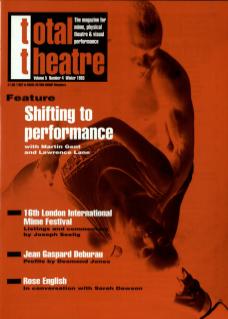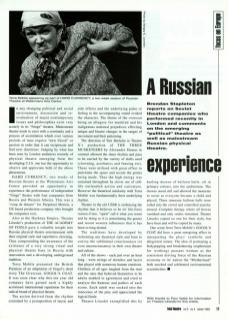In any changing political and social environment, discussion and re-evaluation of major contemporary issues and philosophies exist very acutely in its ‘fringe’ theatre. Mainstream theatre tends to exist with a continuity and a process of assimilation which over various periods of time require ‘new blood’ or passion in order that it can reciprocate and find new directions. Judging by what has been seen by London audiences recently of physical theatre emerging from the developing CIS one has the opportunity to observe and appreciate both of the above phenomena.
Hard Currency, two weeks of Russian theatre at the Watermans Arts Centre, provided an opportunity to experience the performance of independent ‘fringe’ theatre with four companies from Russia and Western Siberia. This was a ‘coup de théâtre’ for Perpetual Motion, a UK-based production company who brought the companies over.
Also at the Hackney Empire, Theatre Litsedei's production of The Academy of Fools gave a valuable insight into Russian physical theatre entertainment with their original style and superlative clowning, thus compounding the awareness of the existence of a very strong visual and physical theatre base in Russia with innovation and a developing underground tradition.
Terra Mobile presented the British Premiere of an adaptation of Gogol's short story ‘The Overcoat’, Gogol’s Coat. It was soon clear why this ten year old company have gained such a highly acclaimed international reputation for their radical brand of physical theatre.
The action derived from the rhythm contained by a juxtaposition of music and side effects, and the underlying pulse or feeling in the accompanying sound evoked the character. The theme of the overcoat was an allegory for mankind and his indigenous national prejudices, effecting unique and bizarre changes in the ranges of movement and their patterning.
The direction of Yuri Berladin in Theatre X's production of The Three Musketeeers by Alexander Dumas in contrast allowed the sheer rhythm and pace to be carried by the variety of skills used (clowning, acrobatics and fencing, etc). These were utilised with great effect to punctuate the space and accent the points being made. Thus the high energy was sustained throughout by clever use of still life, outlandish action and caricature. However, the theatrical similarity with Terra Mobile was fundamentally their underlying rhythm.
Theatre in the old USSR is embracing the rhythm that it believes to be its life-force (raison d'être, ‘spirit’, call it what you want) and by doing so it is assimilating the genres and recent western influences that it has been so long denied.
The traditions have developed by welcoming any theatrical style and form to convey the subliminal consciousness (or even unconsciousness) in their own theatre and culture.
All of the shows – each just over an hour long – were strings of sketches and lazzis that played with numerous human emotions. Children of all ages laughed from the start and the ones that believed themselves to be adults nodded in agreement and tried to analyse the humour and pathos of each scene. Each adult was sucked into the innocence of the play and appreciated the logical finale.
Theatre Litsedei exemplified this by hurling dozens of balloon balls, all in primary colours, into the auditorium. The clowns stood still and allowed the moments to occur as everyone became a child and played. Three immense balloon balls were rolled into the crowd and controlled anarchy ensued. Complete therapy where all frowns vanished and only smiles remained. Theatre Litsedei copied no one for their style, but have been and will be copied by many.
One scene from Terra Mobile's Gogol’s Coat did have a great energising effect in interpreting the play’s symbolic and allegorical nature. The idea of portraying a body-popping and breakdancing (euphemism for working) peasant woman as the consistent driving force of the Russian economy – or its nation, the ‘Motherland’ – both mocked and celebrated environmental eccentricities.

